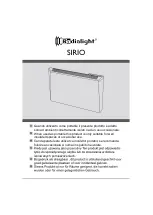
112157-01A
4
For more information, visit www.desatech.com
For more information, visit www.desatech.com
AIR FOR COMBUSTION AND
VENTILATION
WARNING: This heater shall not be installed in a
confined space or unusually tight construction un-
less provisions are provided for adequate combus-
tion and ventilation air. Read the following instruc-
tions to insure proper fresh air for this and other fuel-
burning appliances in your home.
Today’s homes are built more energy efficient than ever. New materi-
als, increased insulation, and new construction methods help reduce
heat loss in homes. Home owners weather strip and caulk around
windows and doors to keep the cold air out and the warm air in. During
heating months, home owners want their homes as airtight as possible.
While it is good to make your home energy efficient, your home
needs to breathe. Fresh air must enter your home. All fuel-burning
appliances need fresh air for proper combustion and ventilation.
Exhaust fans, fireplaces, clothes dryers, and fuel burning appliances
draw air from the house to operate. You must provide adequate fresh
air for these appliances. This will insure proper venting of vented
fuel-burning appliances.
PROVIDING ADEQUATE VENTILATION
The following are excerpts from CAN/CGA B149.1 Natural Gas
Installation Code or CAN/CGA B149.2 Propane Installation Code.
All spaces in homes fall into one of the three following ventilation
classifications:
1.
Unusually Tight Construction
2.
Unconfined Space
3.
Confined Space
The information on pages 4 through 6 will help you classify your
space and provide adequate ventilation.
Unusually Tight Construction
The air that leaks around doors and windows may provide enough
fresh air for combustion and ventilation. However, in buildings of
unusually tight construction, you must provide additional fresh air.
Unusually tight construction is defined as construction
where:
a.
walls and ceilings exposed to the outside atmosphere
have a continuous water vapor retarder with a rating of
one perm (6 x 10
-11
kg per pa-sec-m
2
) or less with open-
ings gasketed or sealed
and
b.
weather stripping has been added on openable windows
and doors
and
c.
caulking or sealants are applied to areas such as joints
around window and door frames, between sole plates
and floors, between wall-ceiling joints, between wall pan-
els, at penetrations for plumbing, electrical, and gas
lines, and at other openings.
If your home meets all of the three criteria above, you must
provide additional fresh air. See
Ventilation Air From Out-
doors, page 6.
If your home does not meet all of the three criteria above,
proceed to
Determining Fresh-Air Flow For Heater Location,
page 5.
Confined and Unconfined Space
The Canadian Gas Association Certification Requirement, CGA
CR94-001 REV. 2 states that when combustion air supply is for the
unvented room heater only, it shall be sized at the rate of one (1)
square inch per 5000 BTU/HR (1.5 KW) from outdoors or the
manufacturer’s specification (whichever is greater). However, com-
bustion air is acceptable when available from the principal heat
source and sized to the current CAN/CGA-B149.1 or .2 require-
ments. Where unvented equipment is installed in an area separated
from a combustion air supply by a door, then permanent openings,
grills or louvers shall be provided. One shall be within 18 inches (46
cm) from the ceiling and one 18 inches (46 cm) from the floor, sized
to one (1) square inch per 1000 BTU/HR (0.29 KW) to allow free
movement of air with the source of combustion air supply.
LOCAL CODES
AIR FOR COMBUSTION AND VENTILATION
Providing Adequate Ventilation
LOCAL CODES
Install and use heater with care. Follow all local codes. In the absence of
local codes, use the latest edition of CAN/CGA B149.1 Natural Gas
Installation Code or CAN/CGA B149.2 Propane Installation Code*.
*Available from www.csa.ca or 1-800-463-6727 (call your local
gas company for your local codes).





































